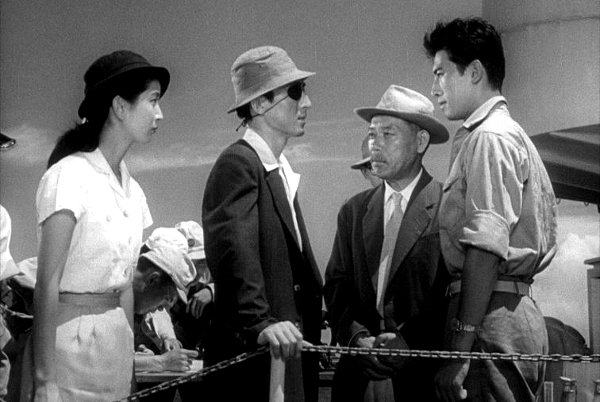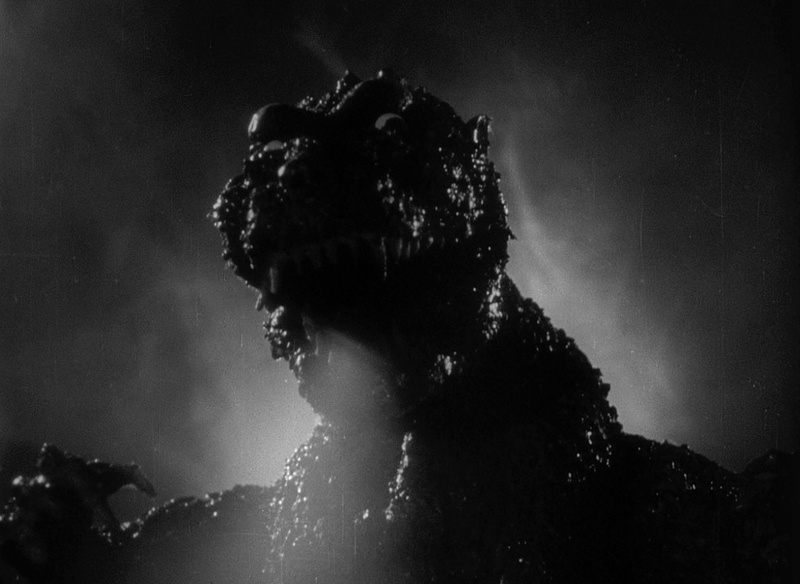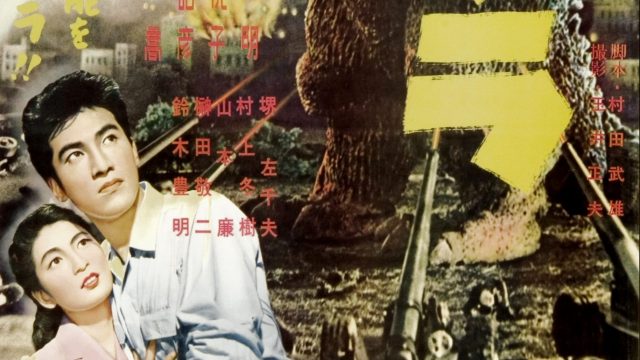The following piece contains spoilers for the film. If you haven’t seen it yet, go watch it and then come back and read.
It’s hard for me to approach the original Godzilla objectively, given how many times I’ve seen it since I was a child and how much it means to me as an adult. I revisit it regularly and continue to marvel at its longevity and its impact, both as a film and a cultural force. For example, not only did it spawn the longest-running film series in history, but it’s also responsible for shaping tokusatsu (Japanese live-action media with heavy special effects), inventing suitmation, and adding kaiju to the lexicon of American monster fans.
Similarly, it establishes what will become staples of the series: political infighting, an oversized and generally futile military response, ecological concerns, and occasionally, basic human drama.
Director Ishirô Honda’s Godzilla was a serious figure, a metaphor for the nuclear horrors of World War II as the monster wreaks havoc on its filmic Tokyo similar to that visited upon the real-life Nagasaki and Hiroshima. He also serves as a reminder of the devastating effects of chasing after the ultimate weapon, as pointed out by Dr. Yamane (Takashi Shimura) after the monster is defeated: “If we continue conducting nuclear tests, it’s possible that another Godzilla might appear somewhere in the world again.” That’s not just an opening to a sequel, by the way; he’s genuinely concerned.
Despite the Godzilla series’ longevity, it wasn’t an automatic hit with Japanese audiences. The American release in 1956, however, brought it back into the public consciousness, resulting in a more positive reception. That version was a staple of my childhood TV-viewing experience. It wasn’t until I was an adult and saw a revival screening of the original 1954 version that my eyes were opened to its deeper glories.
The film’s stature has grown over the years with film fans, but its pleasures remain the same: visceral horror over its nuclear-holocaust-type devastation while simultaneously engendering sympathy for a creature who appears to be living its entire life in agony.
Many pots of ink and bytes of type have been spent on this magnificent creature feature, teasing out themes of nuclear horror and its effect on the Japanese, and science versus political expediency, to name but two. There’s also been numerous articles discussing the change from the dark vision of post-World War II Japan to the “friendly” version cut up and reshot for American consumption.
In fact, the 96-minute original was pared down to a leaner 80 minutes once Raymond Burr was added as Steve Martin, a character who seems to exist more as a “guide” for American audiences through the landscape of Japan than as an actual person we should be rooting for. Martin mostly takes the place of the press from the original, giving similar exposition and putting a familiar white face amidst the horror that obviates America’s part in Japan’s WWII destruction.
Unfortunately, what’s cut to get that leaner run time is the greater family drama between Dr. Yamane and his daughter, Emiko (Momoko Kôchi), as well as the triangle with her lover, Ogata (Akira Takarada), and her betrothed (though apparently not by choice), Dr. Serizawa (Akihito Hirata). Serizawa is also Dr. Yamane’s colleague, making the drama extra-dramatic.

The human scale that takes up the bulk of the film (Godzilla himself shows up for about eight minutes*) is one thing that makes the original so rewatchable. The pull between Dr. Yamane, a zoologist, and his desire to keep Godzilla alive in order to study his amazing ability to withstand and survive massive amounts of radiation (a big concern for a country that had two A-bombs dropped on it), and the military/political axis’ need to destroy a monster it neither understands nor wants to understand (though what Godzilla does to Tokyo gives their position credibility), is a main factor that keeps me coming back to this version versus the one I grew up watching as a kid.
Also, as an avid soap opera watcher, I enjoy love triangles. Here, Emiko is caught between overarching desires in both the macro- and microcosmic senses. She oscillates between her obligation to Serizawa, a scientist with views similar to Dr. Yamane’s, and her love for Ogata, who, as a salvage captain, is more aligned with the military mindset. She even goes to tell Serizawa that she is going to break off their engagement, only to forget about it once he shows her his terrifying new invention, the Oxygen Destroyer. She wants to honor her father and fiancé’s feelings, yet she is pulled toward her lover’s viewpoint.
The drama creates angst for all involved: Dr. Yamane frets about saving and studying Godzilla (“That should be our top priority” he implores). Emiko keeps a secret from her lover on behalf of her betrothed while not letting her betrothed know about her lover. And Serizawa agonizes over telling the world about his new invention because he knows that once it is unveiled, global political powers will want to weaponize it into something as bad as—or worse than—Japan’s own H-bomb testing that has awakened Godzilla (“As a scientist—no, as a human being—I can’t allow that to happen!”). Again, Godzilla-as-metaphor serves as a reminder to a country that seems to have forgotten what nuclear bombs can do, filtered through Serizawa’s conflict between his scientific and emotional natures.
The inner conflict ends for him, though, once he truly sees that Emiko loves Ogata and that his country is suffering terribly because of Godzilla’s rampages. His decision to burn his research and use the Oxygen Destroyer to kill Godzilla makes Emiko cry because she knows the cost to him personally. Once he unleashes the device (during a diving sequence where Godzilla moves poetically through the water), he wishes Ogata and Emiko a happy life together and cuts the line to his own oxygen, sacrificing his life—and his scientific knowledge—for the greater good of humankind**.
More agony comes in the form of Godzilla’s tortured existence and especially in his demise by Serizawa’s horrible weapon. It is one of the saddest creature deaths out there, to me, because we are shown how much Godzilla suffers as he is asphyxiating. At one point, he pops out of the sea briefly, writhing in pain, before sinking to the depths where the Oxygen Destroyer rends the flesh from his bones, eventually dissolving the bones themselves. It’s even more gruesome than Shin Godzilla opening its own mutated, gaping maw. As a little kid, it gutted me, even though I was completely terrified of this giant atomic-breathed “monster.”
That Godzilla has such potent human-scale drama enhances its place in the pantheon of great kaiju films. Metaphors about nuclear power and humanity’s inhumanity to itself aside, the film is a beautifully dark piece from Honda (based on the script co-written by him and Takeo Murata), containing a classic score from Akira Ifukube over powerful images of monstrous destruction and human misery. Seeing the characters struggle not just with the horror unfolding around them, but grappling with philosophical meaning and emotional connections, makes the original film a deeply gratifying experience.
Godzilla himself stomping the crap out of everything around him is pretty cool, too.

*Godzilla appears briefly around minute 22, minute 33, minute 44 min (a slightly longer appearance as he attacks a train), and minute 54 (the main destruction of Tokyo), then again toward the end where he is destroyed.
**There’s a sequence on Odo Island where one elder tells a group of women, “I’ll feed you stupid cows to Godzilla!” for disrespecting tradition, while another explains that they used to sacrifice people to appease Godzilla when fishing was poor, but that the only part of that ritual surviving into the present is the dance that the characters are watching. Godzilla attacks anyway, as if to say, maybe these people aren’t really worth saving.

